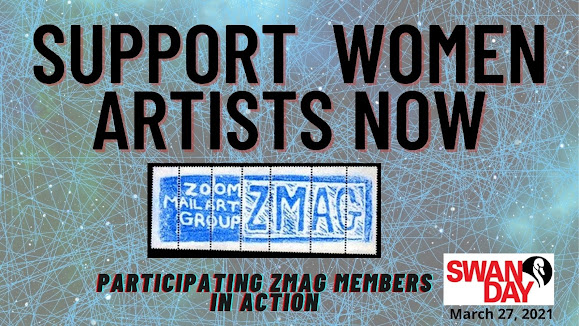Maintain the Hope and the Light
Theo Nelson
ZMAG's on-line collection of art and writing for SWAN DAY 2021
Image of ZMAG stamp by Neosho Background In the fall of 2020, a Zoom discussion platform was founded by Gerda Osteneck and The Sticke...

Mail Art Networks and Women's Issues
The ability of women to see the world in a different context make women’s contribution to art irreplaceable. Their unique approaches to creativity are more often marginalize and unheralded. The female experience is one that has been unappreciated in history and society- from women’s contribution to science (e.g., Hedy Lamarr’s inventions of radio-sonar jamming and traffic lights, Madam Curie) to human rights and social rights (e.g., Elizabeth Peratrovich’s efforts to push Alaska’s Anti-Discrimination Act of 1945 and Zitkala-Sa's preservation of Native American culture through her songs and writings). Although there are many movements that shed light to women’s issues and struggles, these efforts can still be acknowledged as short in goals and, in some cases, a failure. Moreover, the past mistakes seem to creep back from obscurity to contemporary events once again as demonstrated by the #metoo movement.
Joining art groups such as mail art networks present many opportunities to advance women’s issues. First, a network of mail artists can reach larger audience and diverse groups of people across the globe. Members can expand their messages and exchange collective interest amongst themselves great with ease and minimal effort. International exhibitions and exchange collaborations are venues for exposure of one’s works. Furthermore, each participant can also enrich their experiences with issues that affect other women from other parts of the world. Diversity in culture is relative. Women of different heritage and races have different concerns. Their issues may vary from other nations or creeds. Mail art networks provide a symposium for these needs.
Second, women’s contributions may benefit from being referenced more and often in projects, exchanges, and exhibitions. The influences of great women in art and in other fields should be incorporated in discussions and in art projects; this may help introduce and educate people about their merits. Moreover, the role of women in art should be expanded and not be relegated to serve tokenism. Every artist in all spectra of sexuality should freely share their thoughts and creativity with regards to feminine issues. Such is an attainable goal because the totality of the human experience traverses beyond the borders of gender politics and cultural restrictions.
Third, as a collective, mail art networks enable individuals to discover other emerging artists. By corresponding among members of the group, one can find mentors to enhance their techniques, experience, and point of views. It harkens back to the idea of Ray Johnson and the first mail art network of artists who are independent from galleries and cliques. The chance of corresponding with members who may become influential in the future and teaching new artists that may inspire new movements are both worthwhile endeavors. In many instances, there are many organizations and mail networks that are inclusive of all artists and are supportive of women’s issues. Likewise, even few are dominated by artists specifically for feminist reasons like Guerrilla Girls which was formed in New York, 1985 to advance gender and racial equality. Nevertheless, there has been existing kinships that intertwined between many groups that members of one group may also share membership with many other groups.
Fourth, the technology of the digital age makes it possible to preserve artists’ work better. Art works in cyberspace can be catalogued, exhibited and shared using blogs, Instagram, Facebook, etc. Special projects and collaborations can be organized easily and can be spread exponentially to many participants in a brief time with or without physical space for exhibition. Moreover, communication via Zoom, Facetime, and other virtual conferencing application makes real-time interaction with members possible. For those who seek commercial gain for their artworks, there are virtual galleries and portfolios where people can order their works. Afficionados and clients can access and procure artworks through these websites. The traditional infrastructure of gallery-artist model has been updated and forever changed by the restrictions and impact of the COVID-19 pandemic.
Finally, the importance of archiving and publications of art works and information about artists cannot be emphasized enough. Having visual and written works that are published in magazines, books, or websites can enhance the reputation of an artist. The richness of these records has been the backbone of modern art history. Where would Vincent van Gogh be without the publication of his letters to his brother Theo through the efforts of his sister-in-law, Johanna Gezina van Gogh-Bonger? His works have become more relevant after years of struggle to get recognition. Most of his life’s works and iconic paintings were also saved and cared for until their installment into the permanent museum, a legacy of a master artist donated to the city of Amsterdam. This could have not been possible without the outstanding effort of a woman. Succinctly, Mail art network can be a haven for resources dealing with women centric art works and literature.
Image of ZMAG stamp by Neosho